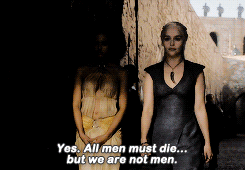Women challenging the rules of the Game of Thrones

Daenerys to Sansa Stark: We have other things in common. We've both known what it means to lead people who aren't inclined to accept a women's rule. And we've both done a damn good job of it, from what I can tell.

In kingdoms, countries or companies, we have mostly seen men in leadership positions. But times are slowly changing and the women of the world have made their own place and proven their potential to manage work outside the home as well.
Whether it is Game of Thrones on-screen or game of thrones in corporate and politics, women have risen above their own inhibitions and battled the stigmas of society quite gracefully. From Indira Nooyi, Theresa May to General Motors CEO Mary Barra, women are challenging the societal norms, patriarchal mindsets and leading people, companies and nations towards a better tomorrow.
However, they are still fewer females in leadership roles, on boards and gender inequality is still a global issue.
Rewind: The potential was always evident
Let's go back to the fictional world and reflect on how the characters of some of the women leads have developed on the show.
While on the one hand, we have Arya Stark, who was always a rebel refusing to follow the rules given by society, on the other, there is Sansa Stark, her sister who as a child dreamt of marrying a prince someday.

From season one to season eight both the ladies have come a long way. The former has learned to channelize her energy and utilize her potential, the latter has discovered the capabilities she never even knew existed.
For decades, women and men have been raised to believe that raising a family and taking care of home is the only purpose of women. But time and again women have proved this mindset to be wrong.

If we look at world history, we have great examples of women taking the reigns and leading realms as well. In 1740, Maria Theresa inherited the rule of a country that was penniless and poorly governed and turned around the economy, revitalized the military, and instituted mandatory public education for both boys and girls in the country. Then in the 1880s, Eleanor Roosevelt set an example and became the First Lady of the United States. She wrote a daily newspaper column that reached vast people, in which she defended women’s rights and other humanitarian causes.
Lesser in number but huge in impact, these hard working ladies became role models for generations to come. And the women workforce on the field, in office, in factories and in almost every sphere of life increased.
The Present: Hope for a better tomorrow
Over time, women have started taking more roles and responsibilities outside the home. Their participation has increased in academics; more of them have started taking up jobs or becoming entrepreneurs.
Today, closer to home, we have many emerging companies and startups founded by women entrepreneurs. For instance, Hooi Ling Tan, a former McKinsey consultant, who co-founded GrabTaxi with her classmate at Harvard, Anthony Tan. GrabTaxi was recently named one of Southeast Asia’s “unicorn” startups with an estimated billion-dollar valuation.
Besides finding and leading disruptive business models, many women have even made it to the top roles in established organizations which for decades didn’t have any female leadership.
Recently, General Motors Co. became one of the few companies to have a board with a majority of women and the cherry on the top is that the person leading the company is also a female. There are other companies like Viacom Inc. and CBS Corp. that also have a majority of female directors, currently.
While the progress is slow, it is also steady.
As per, 2018 CWDI Report, women hold 21.4 percent of all director positions on the boards of the 200 largest companies in the world (the Fortune Global 200), doubling the percentage of women directors since 2004, when only 10.4 percent of board appointments were held by women in these global powerhouse companies representing 26 countries. In the Asia-Pacific region, which now represents the largest slice of the 200 largest companies in the world, there is only 7.4 percent of female representation on their boards of directors.
Slowly but surely women are challenging the mindsets and shattering the glass ceilings to an extent that it shall soon disappear.
The bright future: No men, no women, only leaders
'All men must die, but we are not men'

The slogan ‘Future is female’ may confuse many and make them think that women want to eliminate men completely. However, that’s not the idea. Organizations need to build a culture of equality for it to evolve and move ahead amidst the disruption that the world of work is facing currently.
As per a report by McKinsey Global Institute, India, in particular, could add more than 18 percent to its GDP by 2025, simply by giving equal opportunities to women and increasing the female workforce participation.
Winter is here, and organizations need all the capabilities that they can get irrespective of gender to win the war of talent.
The same as in the series, Game of Thrones, women and men all alike fight against the white walkers so shall in the world of work should they together as per their potential help take businesses and economies ahead.
Gif Credits: Giphy
















